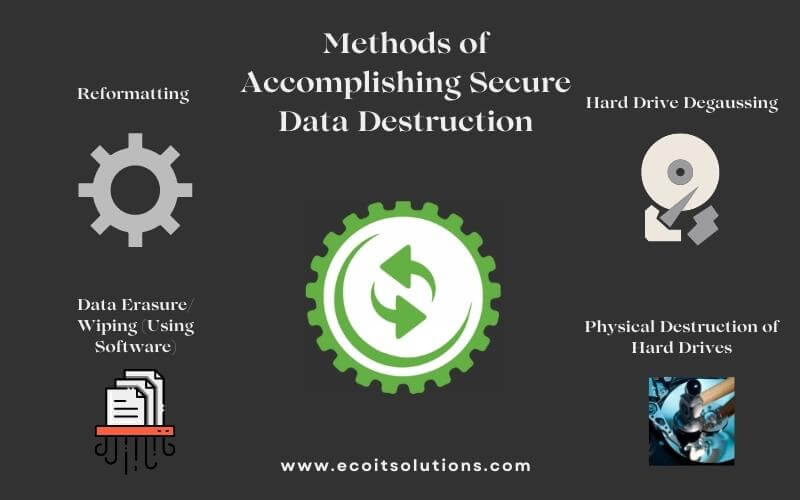The Significance of Effective Data Damage Practices in Safeguarding Sensitive Details and Ensuring Computer Safety
In an era where data violations are increasingly typical, the importance of efficient data devastation practices can not be overstated. Applying robust data devastation methods not only alleviates these dangers but also aligns with legal conformity demands, making certain that organizations maintain their track record and foster customer trust.
Recognizing Information Destruction
Recognizing data destruction is critical in today's digital landscape, where delicate info can quickly be endangered. Efficient data damage involves not just making sure yet erasing files that data is irretrievable via comprehensive methods. This process is crucial for organizations that deal with personal customer details, intellectual residential or commercial property, or internal records, as any type of violation can lead to severe financial and reputational consequences.
Data damage incorporates different methods, including shredding physical media, degaussing magnetic storage gadgets, and employing software-based options that overwrite information numerous times. Each method offers a specific objective and should line up with the level of sensitivity of the info being disposed of. For instance, physical damage is frequently liked for disk drives consisting of very private information, while software application methods might suffice for less delicate info.
Furthermore, adhering to sector standards and regulations, such as the General Data Protection Regulation (GDPR) or the Health Insurance Transportability and Responsibility Act (HIPAA), is necessary for conformity and to reduce lawful threats. Organizations must establish a durable data destruction policy, train workers on best practices, and frequently audit their procedures to make sure that all delicate details is disposed of securely and properly.
Dangers of Inadequate Practices
Poor information damage techniques reveal companies to substantial threats that can have far-ranging repercussions. When delicate information is not effectively thrown away, it continues to be at risk to unapproved gain access to, which can bring about information breaches and identification theft. Such occurrences not only jeopardize the protection of people but also taint the organization's reputation, leading to a loss of customer depend on and potential financial effects.
Additionally, regulatory compliance is increasingly rigid in lots of sectors. Failing to stick to information damage policies can cause hefty penalties and lawful activities against companies. These charges can divert and stress financial resources attention from core business operations.
On top of that, the misuse of residual information can lead to copyright theft or business espionage, jeopardizing competitive benefits (data destruction). The effect of poor information damage expands beyond instant financial losses; it can likewise result in long-term damages to brand name integrity and market placement

Organizations need to recognize that data security is not only concerning preventing breaches; it also encompasses the accountable administration of information throughout its lifecycle. Neglecting effective data damage protocols can have tragic implications, underscoring the need for durable steps to minimize these threats.
Ideal Practices for Data Destruction
Executing efficient data destruction techniques is necessary for securing delicate details and preserving compliance with regulatory requirements. Organizations should embrace a multi-faceted approach to make certain that information is irretrievable, consequently stopping unauthorized access and potential breaches.
First, information ought to be classified based upon level of sensitivity, allowing organizations to apply suitable devastation approaches tailored to the level of threat. For electronic data, utilizing software-based data-wiping devices that adhere to industry criteria can properly overwrite existing information. Physical damage techniques, such as shredding or degaussing, are important for gadgets that save delicate information, guaranteeing full eradication.
Developing a clear information retention policy is vital, describing for how long various kinds of info ought to be retained prior to devastation. Routine audits of information storage systems are also needed to identify obsolete or unnecessary data needing elimination.
Furthermore, training employees on the importance of data destruction and the details protocols to follow visit this site right here fosters a society of safety within the organization. Keeping documentation of data damage refines offers liability and sustains conformity with outside guidelines and interior plans. By sticking to these ideal techniques, companies can dramatically reduce the dangers linked with data direct exposure.
Legal and Compliance Factors To Consider

Failing to follow these guidelines can result in extreme fines, including substantial fines and reputational damage. Organizations should implement a durable data damage plan that straightens with these lawful frameworks and provides clear guidelines on the proper methods of information disposal, whether physical shredding or electronic wiping.
In addition, maintaining documents of data damage tasks is vital for showing conformity during audits or inspections. By prioritizing legal and conformity factors to consider, organizations can improve their information safety posture and foster depend on with customers and stakeholders, ultimately adding to a much more secure information administration setting.
Benefits of Effective Information Destruction
Efficient information damage methods expand beyond simple conformity; they provide significant advantages to companies that prioritize them. By making certain that delicate information is irretrievably damaged, organizations mitigate the risk of information violations and the prospective economic effects connected with them. This positive strategy not just safeguards versus unauthorized gain access to yet likewise boosts the total reliability of the organization in the eyes of stakeholders and clients.
Implementing durable information devastation methods, such as physical destruction of storage gadgets or sophisticated data wiping methods, contributes to the Visit Website conditioning of an organization's cybersecurity position. data destruction. It minimizes the possibility of intellectual residential property burglary and protects exclusive details, consequently maintaining an one-upmanship on the market

Conclusion
In verdict, efficient data destruction techniques are crucial for safeguarding sensitive details and boosting total computer system safety and security. Eventually, a commitment to durable information destruction techniques cultivates a society of responsibility, consequently reinforcing an organization's cybersecurity stance and keeping client depend on.

Comments on “Top Tips for Ensuring Secure Data Destruction in Your Cyber Security Strategy”